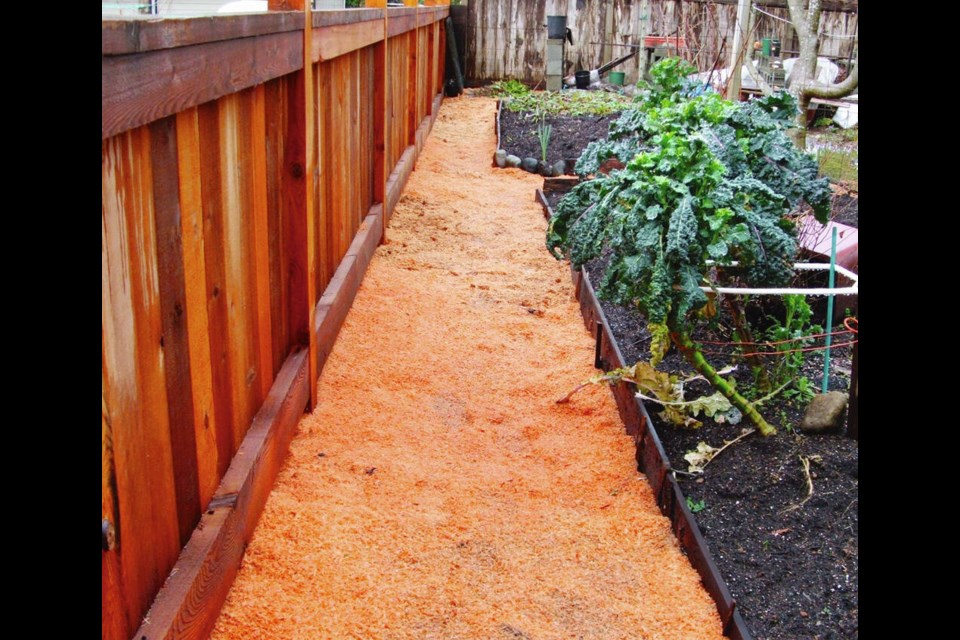Last year’s calamitous environmental events, together with the ongoing effects of living in pandemic times, will influence the 2022 gardening season. Top of mind is lost and damaged farmland, supply chain issues, potential food shortages and food prices increasing at an alarming rate.
My hopeful expectation is that people, taking note of all this, will turn in increasing numbers to growing as much of their own food as possible, in garden plots and in all sorts of containers.
A companion trend, logically, will be to produce that food using methods that will benefit rather than further damage the environment.
Composting is a key component of sustainability in a garden. I tend five compost enclosures, in various stages of decomposition. At the moment three hold “finished” compost ready to be used to prepare vegetable plots for seeding and transplanting.
As soon as one of the ready-to-use enclosures is emptied, it is lined with cardboard and newspaper to prepare it to receive compostable materials. At that point the two others will be covered loosely with plastic sheeting. In the warm spring weather, they’ll be topped with good soil and used for planting winter squash and pumpkin. Those two will yield fine compost for next spring’s planting.
Compost treasure. By the time I uncovered one of the enclosures to use the compost, I’d forgotten that I’d allowed a few self-planted potatoes to grow in the decomposing mass last year. Early this month, when I uncovered the heap and began removing the compost to use on the broad bean plots, I remembered. The compost held a fine harvest of fingerling potatoes, which I recongnized as the red-fleshed AmaRosa and the yellow-fleshed Bellanita.
These fingerlings are delicious halved lengthwise and roasted after being drizzled with oil and dusted with a little salt. I used some for a potato salad with carrots pulled from the garden and Kelsae onion in storage.
Soil and seeding. Both indoor and outdoor seedings are underway. The first seedlings (violas and pansies) are up and growing. Onions, leeks, sweet peas, snapdragon and some shrub seeds are sown.
Few of us will soon forget last year’s drought and heat. With that in mind, I’m taking extra care in preparing beds for seeding. First, I dig sites to be seeded, to remove roots and debris. Then I dig in a hefty layer of finished compost together with coconut fibre (coir) for extra moisture retention.
A dusting of lime and a balanced, slow-release, natural-source fertilizer are the final additions before it is all mixed into the seed bed. A naturally plumped and enriched soil is the surest path to healthy, productive growth and nutrient-rich, tasty, health-promoting edibles.
Re-use, recycle. Another trend, again in view of a clearly challenged environment, is to use what is on hand, or what others are discarding, for various gardening projects. Plant a flower garden in an old wheelbarrow. Cut vinyl blinds into plant labels.
I do most of my indoor seeding in flats made from two-litre beverage cartons that neighbours save for me. Small, well-aged area rugs serve a useful purpose as weed suppressors. I place them on especially weed-troubled spots on pathways as I clean and recover paths with cardboard, newspaper and wood shavings.
Colour therapy. The last two years have been a bit of a worrisome drag. As the weather warms, many of us will be spending as much time as possible outdoors — the safest place to be.
Our gardens provide that outdoor time, and spirit lifting cheer as well when we plant plenty of colourful flowers. Early in the month I bought three beautiful primulas, which I placed on the patio, in a plant stand next to the family room, where I can enjoy that cheery glimpse of spring often.
Consider indulging in your favourite brightly coloured flowers for this summer’s garden. Plant them in flower beds and pots. Edge vegetable plots and fill plot corners with them. Congratulate yourselves for getting through the past two years with patches of bold and glorious reds, yellows, oranges and purples.
HPC family day. The Horticulture Centre of the Pacific, 505 Quayle Rd. in Saanich, is offering admission by donation to the gardens on Family Day Monday, from 10 a.m. to 3 p.m. Child and Youth programs from 10 to 2 will include guided walks, crafts, and other activities.



